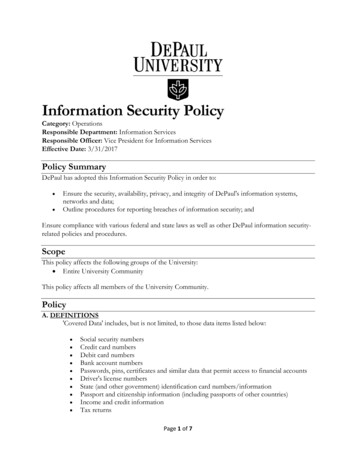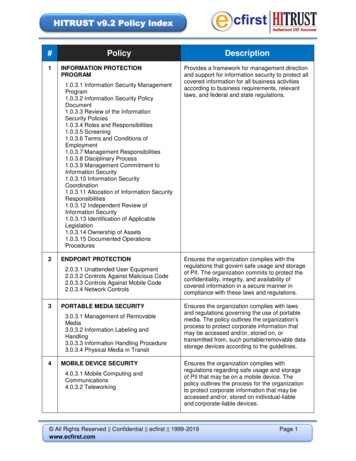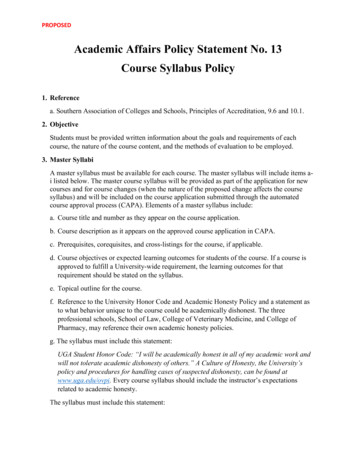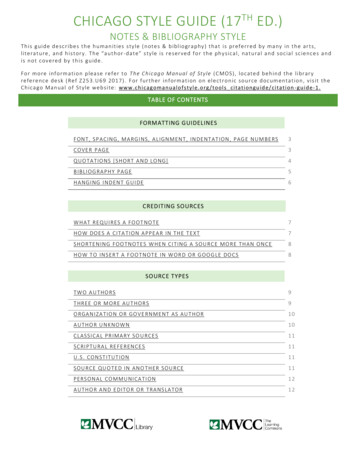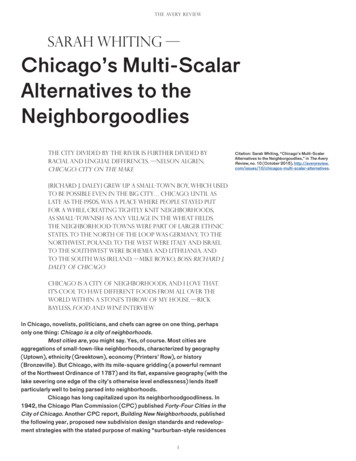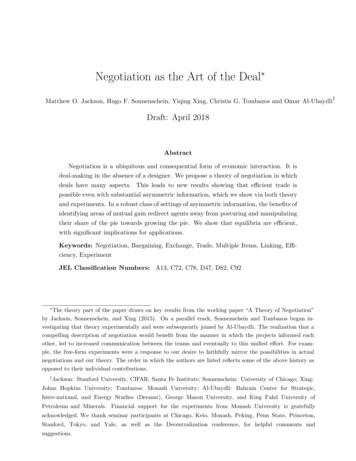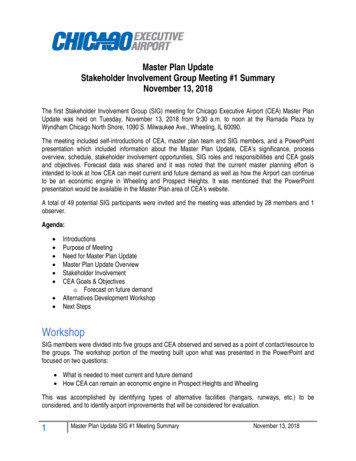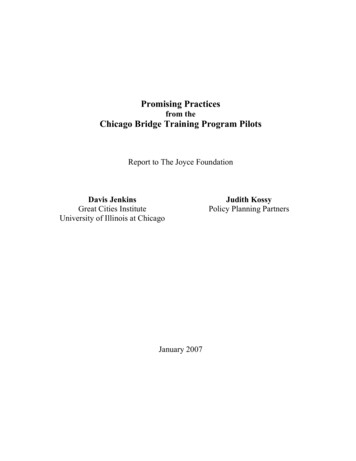
Transcription
Promising Practicesfrom theChicago Bridge Training Program PilotsReport to The Joyce FoundationDavis JenkinsGreat Cities InstituteUniversity of Illinois at ChicagoJanuary 2007Judith KossyPolicy Planning Partners
AcknowledgementsThe authors would like to thank the all of the faculty and staff of the three bridge programsprofiled in this report who provided valuable information and insight. We are also grateful tothe students who took time to share with us their life stories. In addition, we want to thank theleaders of the organizations that have partnered to create these bridges to postsecondaryeducation and careers for agreeing to participate in our formative evaluation. We’d also like tothank Toni Henle at Women Employed for her review of drafts of this paper. Finally, we thankThe Joyce Foundation for its generous support of this work, and our program officers, ShelleyDavis, Jennifer Phillips, and Whitney Smith, for their guidance.Key program contacts included:Carreras en SaludTom DuBois, Director of Workforce Programs, Instituto del Progreso LatinoDr. Ricardo Estrada, Project DirectorMadeline Roman-Vargas, Dean, Humboldt Park Vocational Education Center, WrightCollege, City Colleges of Chicago (CCC)Julie White, RN, MSN, Dean, Allied Health Programs, Wright College, CCCOlive-Harvey College, City Colleges of ChicagoBen Greer, Dean of Adult EducationJoanne L. Ivory, Executive Director, Transportation, Warehousing and LogisticsTruman College, City Colleges of ChicagoAnn Darnton, Assistant Dean, Adult EducationArmando Mata, Dean, Adult Education
OverviewThis paper presents lessons learned from a formative evaluation we conducted of Chicagobased bridge training pilot programs. Bridge programs are designed to prepare adults withlimited basic skills for postsecondary education and training leading to career-pathemployment.The three pilot efforts included in the evaluation were: Carreras En Salud, which includes a bilingual pre-Certified Nurse Assistant bridge anda Certified Nurse Assistant to Licensed Practical Nurse bridge program. The Carrerasprograms are provided through a partnership involving two community organizations,Instituto del Progreso Latino and Association House, Wright College’s Humboldt ParkVocational Education Center, and the National Council of La Raza. Students enterprograms based on their literacy levels and each program prepares them to enter thenext level of training. Olive-Harvey College’s Transportation, Warehousing and Logistics Bridge programprepares students with a 6th to 8th grade literacy level for the GED exam and to enter thecollege’s Commercial Drivers License program. The Automotive Bridge program run by Truman College in collaboration with twononprofits, Howard Area Community Center and Jewish Vocational Services. Itprepares students to enter Truman’s automobile repair certificate program and associateof applied science degree program in automotive technology.We interviewed administrators, staff, faculty and students, reviewed program materials, andobserved classes. We also participated in meetings that brought together programadministrators and staff and Chicago City College district office representatives to discusschallenges and share solutions. In February 2006, we presented summaries of our findings onthe strengths of each program and suggestions for improvement.This paper identifies promising practices of the three bridge program pilots. It also discussesthe obstacles to bringing bridge training programs with these promising practices to scale, andsuggests possible strategies for overcoming such obstacles. In the conclusion, we presentsuggestions for what leaders at the state and local level can do to advance bridge programdevelopment to the next stage in Chicago and throughout Illinois. Profiles of bridge programstudents are presented in the appendix to this report.Promising PracticesIn this section, we describe practices that staff, faculty and students of the three pilot effortsmentioned as positive features of their programs. We refer to these practices as “promising”because they have not been rigorously evaluated and many are still in development.Promising Practices from Chicago Bridge Pilots1
Clear connections to jobs through strong relationships with employers. Strong connections toemployers and jobs are critical both to ensure the relevance of bridge programs and to motivatestudents to endure what is for most a challenging academic experience. Carreras en Salud isstrongest in this regard. The Carreras staff aggressively reached out to hospitals and homehealth agencies, seeking input on the design of its bridge programs and assistance withmonitoring their progress. Carreras designated a staff person to spearhead outreach toemployers through breakfast meetings and one-on-one visits at the employers’ offices. As oneCarreras staff member said: “We haven’t done anything without the input of employers.” TheCarreras program has the additional advantage of having staff dedicated to helping studentsfind jobs during and after their training.Truman also expanded its employer relationships during the pilot. The lead instructor in theTruman automotive program, who worked in the industry, said that “these industries arecommunities, and you need to develop ties in them.” He added that “personal contact is key.”This instructor went out and talked to local employers to get feedback on the program design,recommendations of other employers and agreements to consider hiring students from theprogram. As a result, several employers donated equipment and others that hired graduateshave asked for additional students. Olive-Harvey built relationships with employers intrucking and other transportation industries that are eager to hire graduates of the college’stransportation program. One of the students we interviewed cited that relationship as one ofthe most valuable features of the program.Clear connections to college-level programs. Most bridge program students have littleexperience or information about postsecondary education. The staff at all three pilot sitesemphasized that bridge program students need a substantial amount of handholding to helpthem through the process of applying for college-level programs and financial aid. Trumanexpanded its automotive bridge to 64 hours from the original 32 in large part to devote moretime to preparing students to pass the COMPASS test, which qualifies them for entry intocollege-level programs. The program also exposed students in the bridge to the college’sautomotive certificate programs and piloted using students in the college-level program asmentors to bridge students. The Carreras program incorporates instruction in study skills, testtaking, time management and critical thinking.First step on a career path. Ideally, bridge programs are the initial step in a series ofinterconnected education and training programs that support advancement to successivelyhigher levels of education and employment and that enable students to “stop out” and return astheir circumstances permit. Carreras, which starts with bridges to CNA training and continuesto the LPN and RN levels, was explicitly designed to create “career pathways" in healthcare.During the course of the pilot, Carreras and Olive-Harvey developed lower level bridgeprograms to serve those with 5th – 6th grade literacy levels. Truman’s automotive bridge,which has a minimum 9th grade literacy entrance requirement, prepares students to enterTruman’s automobile repair certificate program and associate of applied science degreeprogram in automotive technology, which in turn prepare students for jobs as technicians in theautomobile industry.Promising Practices from Chicago Bridge Pilots2
Career and college guidance. The three pilots highlight the role bridge programs play insocializing students to the culture of postsecondary education and career-path employment.The majority of interviewees felt that the bridge program gave them an invaluable opportunityto improve themselves and the confidence to take the next step in education and careers. Moststudents did not have a well-formed concept of career or plans for the long term. In most cases,their main objective was to get a better job. The bridge programs introduced them to jobs theywould qualify for at the end of the bridge as well as to the types of jobs at subsequent levels ofcareer ladders in those fields. Through their lessons, interaction with teachers, other students,and employers, and exposure to careers and postsecondary education, students were able todevelop clearer plans for the future.Instructors as the “hub” of the program. Most of students we interviewed said that the facultywere the most valuable part of the program. Students from all three programs said thatinstructors helped them not only with their coursework, but also with time management,confidence building, motivation, personal issues and thinking about careers and jobs. Indescribing their impression of the instructors, students used phrases like, “she gave us what weneeded,” “he was always there for me,” and “he challenged us to do better.” One womanspecifically said that she was on the verge of dropping out, but her instructor helped herovercome her insecurities and stay in the program. Several other students said without theinstructors’ care and encouragement, they would not have completed. Instructors clearly spenta lot of time with the students in and outside of the classroom.Wrap-around support services. All three of the pilots recognized the importance of personalguidance and support to student retention, completion and transition rates. Olive-Harvey’sexperience is the most dramatic. Retention and transition rates in the college’s transportationbridge increased dramatically when it hired an advisor to guide and motivate students toovercome personal doubts and challenges and help them find transportation, child care andother supports as needed. Students in the Carreras program benefited from the casemanagement and other supports provided by the community organization partners in theproject.Targeted marketing and recruitment. Bridge programs will likely be most successful whenthey recruit individuals who have an interest in and an aptitude for the particular career fieldsthey target. Carreras had the best developed approach to recruitment, working with hospitalsto recruit incumbent certified nursing assistants (CNAs) and with college admissions staff toidentify individuals who applied for the licensed practical nurse (LPN) program at WrightCollege’s Humboldt Park Vocational Education Center, but who lacked the necessaryqualifications. They recruited for the CNA bridge program by networking in the community.Carreras also sought to build broader awareness and support for the program by informingaldermen and other community leaders about it. Individuals such as these will help spread theword about the program to community residents and, in some cases, to employers. TheCarreras staff also sponsored breakfast meetings with local clergy and spoke to congregationsto get the word out. In addition, the staff made presentations at local primary schools toencourage the students to start thinking about college and careers early on and tell their parentsabout the program.Promising Practices from Chicago Bridge Pilots3
Truman College worked with Howard Area Community Center (HACC) to recruit for itsautomotive bridge. In the first cycle of the program, HACC only referred a couple of its clientsto the program, but, given the positive reviews by these initial clients, HACC stepped up itsrecruitment in subsequent rounds.Over the course of the pilot, Olive-Harvey College worked on with the Chicago HousingAuthority and the Chicago Department of Human Services on creating a process to recruitCHA residents for the transportation bridge program. This relationship has helped the collegerecruit students for the program and opened up education opportunities for CHA residents.Olive-Harvey’s decision to lower the entrance requirements for the bridge to the 6th grade levelwas motivated in part by a desire to serve more CHA residents through the program.Student tracking to support program evaluation and improvement. All three sites indicatedthat they would ideally like to have the capacity to track whether or not students are indeedable to advance to the next level of education and employment. Instituto del Progreso Latino,one of the partners in Carreras, has an information system that it uses to track clients into theworkplace, but Instituto’s system is not connected with the City Colleges’ PeopleSoft studentinformation system. Truman College has “flagged” bridge students in PeopleSoft trackingsystem, but it has not yet analyzed this information to, for example, compare the rate at whichbridge students advance to college-level programs with that of students in its adult literacyprograms (particularly the upper-level ESL students, who are most similar demographically tothe students in the automotive bridge).Top-level support. All three pilots have benefited from the commitment and support by theleadership at each of the partner organizations. The presidents of the three City Collegesinvolved – Olive-Harvey, Truman and Wright – have championed their programs within theirinstitutions and with outside stakeholders. This sort of leadership will be essential if bridgeprograms are to move beyond the pilot stage and be offered on a substantial scale.Obstacles to Bringing Bridge Programs to Scale (and Possible Solutions)The following table shows statistics on the bridge pilots to date, including the number ofclasses or cohorts that have been offered in each case, and the number of participants who haveenrolled, completed and advanced to the next level of education and training.ProgramCarreras en SaludPre-CNA BridgeCNA to LPN BridgeOlive-Harvey CollegeTransportation BridgeTruman CollegeAutomotive Repair 3949951283655342Promising Practices from Chicago Bridge Pilots4
This section examines obstacles to offering on a much larger scale programs that embody eachof the promising practices described above, and identifies some ways in which such obstaclesmight be overcome.Clear connections to jobs through strong relationships with employersCommunity college occupational programs often form employer advisory boards, but, forbridge programs to be successful, the ties to employers need to be even closer – more like therelationship in the private sector between firms that supply products or services to otherbusinesses and their customer firms. Many community colleges have contract trainingdivisions that do have customer-focused relationships with employers through which theyprovide training and other services customized to the employers’ needs. But communitycollege customized training staff often have little contact faculty in the college-creditprograms.Colleges in many cases need to take a much more strategic approach to working withemployers. According to the Carreras staff, for example, a college’s president in the institutioncan help build strong employer relationships by reaching out to the executives of firms inindustries targeted by bridge programs and advocating bridge programs as one solution to theirworkforce needs. A staff person at Humboldt Park Vocational Education Center offered thefollowing advice on how to strengthen ties to employers: “Open your doors to professionalassociations. Allow them to use your facilities for meetings. They may not know about younow, but they are looking for places to meet and this allows them to get to know yourprograms.” Building and maintaining strong relationships with employers ideally requireshaving a designated staff person who is responsible for employer outreach. Finding funds tosupport such a position beyond limited term grants is a challenge, however.Ideally the relationship with employers in bridge programs goes even further and includesintegrated job placement services. Yet community colleges generally do not have the staff orresources to provide direct job placement. One solution is to build relationships withorganizations that do provide such services. This is one of the strengths of the Carrerasprogram, in which Wright College is partnering with Instituto del Progreso Latino, which haslong experience doing job placement.Clear connections to college-level programs leading to a career pathBridge programs are needed precisely because most programs for adults with low literacy arenot well connected to college-level occupational programs, nor do they prepare students to passthe placement tests and succeed in the “general education” courses (math, English, psychology,etc.) needed for degrees. At the October 2006 meeting of the bridge program “learningcommunity” being organized by the Chicago City Colleges and Women Employed,participants from the City Colleges identified as top priority the need to work with colleaguesin their colleges and district office staff to better align the adult education program curriculumwith college entrance requirements (particularly the COMPASS placement standards) and withthe basic competencies needed for success in college-level coursework leading to bothcredentials and employment in the targeted fields. Only through such system-wide alignmentPromising Practices from Chicago Bridge Pilots5
of curriculum and standards will bridge programs become integrated into the fabric of collegeofferings and situated as the first step on a career pathway.Career and college guidanceCommunity colleges have academic advisors, financial aid staff, and career counselors, butgenerally they serve students in college-credit programs. Most colleges have far fewer studentservices staff than are needed to adequately serve their credit-program students, so students inbridge programs and other non-credit offerings often have to turn to the instructors for adviceor figure it out on their own. Bridge program instructors do their best to provide guidance tostudents, but many of them work part-time and few have detailed knowledge of admissions,financial aid, program offerings, and other information that could help prepare their students toenter college-level programs.Truman College responded to this need by reprogramming grant funds to hire a part-time“advocate” who helps bridge program students explore their college options and guides them tothe necessary support services. The bridge staff also convened staff from the college’s studentservice offices to discuss ways to support students in making the transition to college-levelwork. Olive-Harvey similarly hired a part-time student advisor to work with bridge students.Truman has begun to incorporate guidance on registration and financial aid as well as careercounseling into course hours. This way, the instructors get paid for the advising they areotherwise providing on their own time. There are models for this. Most community collegesoffer “college success courses,” which typically include units on college and career guidanceand planning. Such courses offer an opportunity to help students improve basic skills such asreading, writing and math in the context of exploring options for college and careers andlearning note taking, test taking, time management and other skills needed for success incollege and careers.Professional developmentBecause funding for support services is limited, bridge program instructors have to wear manyhats: teacher, motivator, academic advisor, tutor, personal counselor, and employment coach.They have to be knowledgeable about the field for which they are training and open to teachingbasic skills in the context of technical content. Attracting individuals with these qualificationscan be difficult, particularly since bridge instructor positions tend to be part-time and withoutfringe benefits.The staff of the Carreras program said
a Certified Nurse Assistant to Licensed Practical Nurse bridge program. The Carreras . their circumstances permit. Carreras, which starts with bridges to CNA training and continues to the LPN and RN levels, was explicitly designed to create “career pathways" in healthcare. . HACC only referred a couple of its clients to the program, but .
